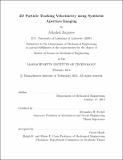| dc.contributor.advisor | Alexandra H. Techet. | en_US |
| dc.contributor.author | Bajpayee, Abhishek | en_US |
| dc.contributor.other | Massachusetts Institute of Technology. Department of Mechanical Engineering. | en_US |
| dc.date.accessioned | 2015-07-31T18:17:59Z | |
| dc.date.available | 2015-07-31T18:17:59Z | |
| dc.date.copyright | 2014 | en_US |
| dc.date.issued | 2014 | en_US |
| dc.identifier.uri | http://hdl.handle.net/1721.1/97940 | |
| dc.description | Thesis: S.M., Massachusetts Institute of Technology, Department of Mechanical Engineering, 2014. | en_US |
| dc.description | This electronic version was submitted by the student author. The certified thesis is available in the Institute Archives and Special Collections. | en_US |
| dc.description | Cataloged from PDF version of thesis. | en_US |
| dc.description | Includes bibliographical references (pages 63-65). | en_US |
| dc.description.abstract | 3D visualization of fluid flow is of critical significance to a number of applications ranging from micro-scale medical devices to design of ships and airplanes. Of the various techniques currently used to visualize flow fields, particle image velocimetry (PIV) offers great advantages because of the high resolution quantitative results it provides. The feasibility of using synthetic aperture (SA) imaging to conduct 3D Particle Image Velocimetry (PIV) has been previously demonstrated. This thesis presents the development of a technique that extends SA imaging to 3D Particle Tracking Velocimetry (PTV), adding the ability to conduct Lagrangian studies on flow fields over time. A new method has been developed to accurately locate seeding particles in volumes reconstructed using SA imaging, based on a proposed thresholding and average intensity based scheme, which is able to locate particles in densely seeded flows. In addition, a new and much faster method for reconstructing volumes, based on a homography fit (HF) refocusing method, is proposed which facilitates rapid processing of large amounts of data recorded using high speed cameras for example. The capability of using SA imaging to conduct PTV is demonstrated by tracking located particles using the relaxation based algorithm. The developed technique provides accurate and high resolution PTV results at a much higher computation speed compared to other state of the art techniques. If engineered further,the presented technique has the potential to become the method of choice to conduct velocimetry. | en_US |
| dc.description.statementofresponsibility | by Abhishek Bajpayee. | en_US |
| dc.format.extent | 65 pages | en_US |
| dc.language.iso | eng | en_US |
| dc.publisher | Massachusetts Institute of Technology | en_US |
| dc.rights | M.I.T. theses are protected by copyright. They may be viewed from this source for any purpose, but reproduction or distribution in any format is prohibited without written permission. See provided URL for inquiries about permission. | en_US |
| dc.rights.uri | http://dspace.mit.edu/handle/1721.1/7582 | en_US |
| dc.subject | Mechanical Engineering. | en_US |
| dc.title | 3D particle tracking velocimetry using synthetic aperture imaging | en_US |
| dc.title.alternative | Three dimensional particle tracking velocimetry using synthetic aperture imaging | en_US |
| dc.type | Thesis | en_US |
| dc.description.degree | S.M. | en_US |
| dc.contributor.department | Massachusetts Institute of Technology. Department of Mechanical Engineering | |
| dc.identifier.oclc | 880675869 | en_US |
